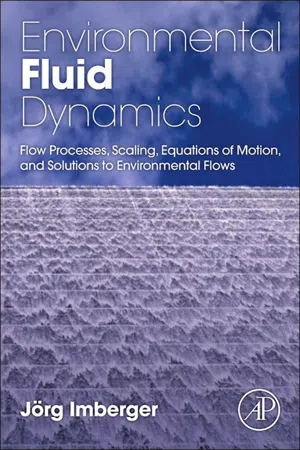
Environmental Fluid Dynamics
Flow Processes, Scaling, Equations of Motion, and Solutions to Environmental Flows
- 460 pages
- English
- ePUB (mobile friendly)
- Available on iOS & Android
Environmental Fluid Dynamics
Flow Processes, Scaling, Equations of Motion, and Solutions to Environmental Flows
About this book
Environmental Fluid Dynamics provides an introduction to the principles of environmental fluid dynamics, i.e., nature's use of air and water to transport and transform waste into nutrients for various organisms.The author, a Professor of Environmental Engineering and the Director of the Centre for Water Research at the University of Western Australia, is careful to include the appropriate mathematical expressions for the fundamentals of fluid dynamics without overburdening the reader with difficult or extensive notation.Starting with a discussion of the basics of fluid dynamics for undergraduates, the book moves on to more detailed material for graduate students and specialists in environmental engineering and/or science, physical limnology, estuarine dynamics, and coastal oceanography. Topics covered include equations of motion, fluid viscosity, environmental hydraulics, mixing and dispersion, surface waves, and environmental flows. The materials presented are based on the author's 40 years of teaching fluid dynamics at Berkeley, Caltech, Karlsruhe, Padova, and Western Australia.The book provides a basic overview, while specialists needing more in-depth information can to turn to advanced texts in their specific areas of interest.- Introduces the principles of fluid dynamics, follows with simple applications, and builds to more complex applications experienced in the field- Offers a unique, authoritative, and accessible treatment of the subject- Includes appropriate mathematical expressions without overburdening the reader with difficult or extensive notation
Frequently asked questions
- Essential is ideal for learners and professionals who enjoy exploring a wide range of subjects. Access the Essential Library with 800,000+ trusted titles and best-sellers across business, personal growth, and the humanities. Includes unlimited reading time and Standard Read Aloud voice.
- Complete: Perfect for advanced learners and researchers needing full, unrestricted access. Unlock 1.4M+ books across hundreds of subjects, including academic and specialized titles. The Complete Plan also includes advanced features like Premium Read Aloud and Research Assistant.
Please note we cannot support devices running on iOS 13 and Android 7 or earlier. Learn more about using the app.
Information
Chapter 1
Physical Quantities, Dimensional Analysis, Scaling and Bulk Conservation Equations
Contents
1.1 Physical Quantities
Table of contents
- Cover image
- Title page
- Table of Contents
- Copyright
- Dedication
- Preface
- Acknowledgments
- Chapter 1. Physical Quantities, Dimensional Analysis, Scaling and Bulk Conservation Equations
- Chapter 2. Equations of Motion: Axiomatic Approach
- Chapter 3. Some Exact Solutions
- Chapter 4. Effect of Viscosity
- Chapter 5. Fundamentals of Hydraulics
- Chapter 6. Environmental Hydraulics
- Chapter 7. Mixing in Environmental Flows
- Chapter 8. Surface Waves
- Chapter 9. Environmental Flows
- Appendix 1. Mathematical Preliminaries
- Index